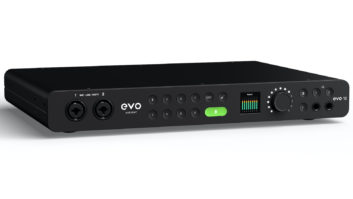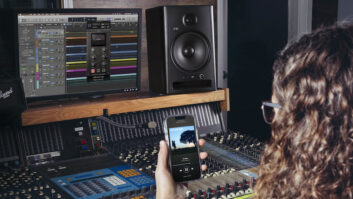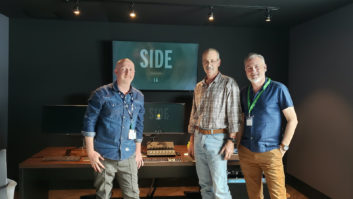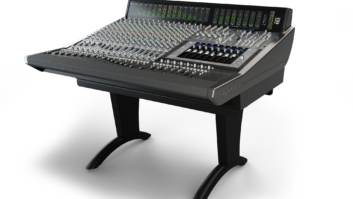
Combining flexibility with its moderate price ($3,295 list) and high-quality AD/DA conversion, the Lynx Aurora continues the traditions of a company known for its enthusiastic customer support and dedication to multiplatform digital audio. Both 8- and 16-channel versions of Aurora can function as stand-alone converters, yet the optional AES16 AES/EBU PCI slot interface card (with its companion virtual mixer) lets users set up complex routings with remote capabilities.
Aurora has the necessities for audio acquisition/playback without some of the pricey extras that mastering facilities and careful audio engineers tend not to use, such as soft distortion or soft clipping limiters. At the same time, its SynchroLock™ feature provides immunity to jitter, making it ideal for both audio capture at high sample rates and precise playback for critical listening.
Although Aurora operates as a stand-alone converter, for optimal use, it’s better to pair it with the Lynx AES16 PCI interface card for individual channel control, levels and monitoring from your computer.
LOOKING AT THE FRONT
Aurora’s layout is clean, intuitive and visually appealing. Settings are easy to see, even across a dim control room. Users can select from six supported sample rates (44.1, 48, 88.2, 96, 176.4, 192 kHz) from internal sync. Locked to external sync, the corresponding sample rate LED glows.
A sync source switch has LEDs to indicate internal, word clock, EXT/2 (with word clock at half the sample rate for dual-wire AES/EBU devices), and AES A or AES B. An LSlot setting derives sync from an optional LSlot/LStream card in the LSlot expansion port. LSlot is currently used for the LT-ADAT Lightpipe card. A FireWire LSlot card is slated for Q3 2006. The SynchroLock LED flashes while the converter is seeking and locking to incoming clock, and it glows solid when locked. SynchroLock can be disabled for wide-range analog PLL.
One signal source routing switch toggles among three analog sources: analog in, AES in and LSLOT in. Press the switch a fourth time and the front panel enters Bypass mode, with routing managed by external control. The To Digital Out switch selects from analog in, the AES in port and LSLOT in. Similarly, a fourth press of that switch selects routing by external control.
Aurora uses the IrDA protocol to control parameters, meters and settings via handheld, laptop or desktop PC with infrared capabilities. You can also program the firmware via IR or MIDI. A large front panel window has a MIDI/IR activity LED and two rows of LED peak meters displaying I/Os.
With the meter switch set to analog, the Trim/AES Mode sets the analog inputs to +4 dBu or -10 dBV. Set for digital inputs, Trim/AES Mode sets AES I/O to Single-Wire I/O mode, Dual-Wire Input mode, Dual-Wire Output mode and Dual-Wire I/O mode. Switching any set of channels to dual wire reduces the set of channels by half.
ON THE FLIPSIDE
Aurora’s back panel has six 25-pin D-Sub connectors: four for analog I/O in sets of eight channels, and two for AES I/O in sets of eight (port A and port B). Analog pinouts conform to the Tascam DA-88 standard, while digital pinouts are in the Yamaha MY8AE96 YGDAI standard.
MIDI in/out ports let users control or update firmware through a computer’s MIDI interface. The LSlot expansion port accepts the LT-ADAT Lightpipe I/O card and provides for other future formats, such as FireWire. BNC word clock in/out connectors allow the unit to be externally clocked (or to clock) downstream devices.
Normally, when I’m working with AD/DA conversion, I like to see a sensitivity adjustment for the converter’s I/O. Lynx decided to forgo the electronic gain stage to reduce distortion and provide 16 channels of A/D and D/A in one rackspace. However, two versions of Aurora with fixed gains of +18 dBu and +24 dBu are available.
A REAL-WORLD APPLICATION
I’ve been recording and mixing in surround for nearly a decade. Often I’ll find myself dissatisfied with stereo sound effects, so I’m gathering samples for 5.1FX, a company that will specialize in online surround sound FX.
To test Aurora, I set up JamSync’s Soundfield Mark V multichannel mic in two different ambient environments. I wanted to test differences in capture at 48, 96 and 192 kHz. To experience the difference in two rooms (kitchen and bathroom) regarding perception of room size. I recorded an egg-shaped shaker, ring of keys, Martin D-41L, a flute, ponytail holder with two hard plastic beads, tambourine and suspended triangle.
An SP451 processor was connected to the Aurora 16’s analog input; Aurora’s analog out was overpatched into the third bank of the room’s Studio Technologies’ StudioComm Model 59 Control Console. I used Aurora’s internal clock; SynchroLock was on for both Aurora and AES16.
I installed Nuendo Version 3.2.0.1128 on my kitchen’s modest Gateway disk printer server (Celeron 2.93 GHz with 496 MB of RAM) running XP Professional V. 2002 with Service Pack 2. I popped in the AES16 card (installed the WDM driver for XP), plugged in the two 8-channel CBL-AES1605 cables between Aurora and the internal card, and inserted the CBL-AIN85 and CBL-AOUT85 cable pairs for analog I/O.
I created six different Nuendo projects: “kitchen” at 48/96/192 kHz and “bathroom” at the same rates. I recorded the instruments taking output from the SP451 as L, R, C, LFE, Ls and Rs. Watching for overs in the signal chain was important, but I let a few slip to hear how they sounded.
PUT IN PLAYBACK
I wanted to hear playback in the control room, but with the computer in the kitchen, I devised a solution for remote playback. From a Gateway notebook, I could control Nuendo via XP Professional’s Remote Desktop feature with a wireless connection.
At this point, I depended on the Aurora Mixer applet to change sample rate when I switched project playback. I wish the ASIO driver could feed that metadata to the mixer so I could just swap sessions. The mixer helped me troubleshoot playback when I realized I was hearing Ls and Rs out of my side dipole speakers. In a matter of seconds, I could track down my routing mistake.
Aurora sounded very good at all three rates, and I got a good perceptual sense of the two spaces. The ponytail bead bounced from the bathroom floor into the bathtub on one trial, and I laughed out loud at the obvious bathtub ambience. On flute, a couple of bursts that tripped the overload on the SP451 were rendered as a kind of “dup-dup” sound rather than a hideous burst of noise or a mute. Strings on the Martin rang true, but at 192 kHz, the fact that they weren’t brand new was more apparent, as was the horrid, cramped space of the tiny, reverberant bathroom.
The surprise was the triangle recording. In “real life,” a triangle’s decay is a series of complex intertwining drones that wax and wane as the volume decreases. At 48 kHz, these drones seemed to be punctuated by beats, as though the triangle was being restruck softly over and over. At 192 kHz, the drones developed more smoothly into one another. In the middle was 96 kHz, with perceptual elements of the other two sample rates.
All three sample rates provided fine results, but I preferred 192 kHz for imaging and “room feel.” For surround sound effects capture, the Aurora 16 with the AES16 card proved a very flexible system that allowed the capture of sound effects at multiple sample rates with just a few keystrokes.
THE FINAL TALLY
Lynx consistently produces quality products at moderate prices, so it’s no surprise that the Aurora provides superior sound for less than other converters with similar features. With a larger system, the integration of the Aurora and the AES16 is definitely the way to go. The mixer application is perfect for those of us who like to leave our equipment in the machine room.
I liked the Aurora 16, and I’m definitely considering it for a portable surround sound capture rig. For me, the most important part of the recording process isn’t mastering; it’s at the other end. I especially liked the Aurora’s 96kHz and 192kHz results.
The only addition I’d like to see is a sensitivity adjustment for the I/O and the forthcoming FireWire card for portability. With the next revision of Final Cut Pro supporting multichannel 96kHz audio — it’s stereo at the moment — it will be intriguing to learn how well portable systems can capture HD video and multichannel audio simultaneously. I’m hoping on-site recording with a Mac Book Pro, the Aurora and a PDA with IR becomes a workable reality in the near future. But overall, the Aurora delivers high-quality conversion at a modest price, with system integration that works with modern studio technology. Note: Lynx just announced LSlot interfaces for connecting Aurora 8 or 16 converters to Pro Tools|HD systems, with parameter control from the PT environment.
Lynx Studio Technology, 949/515-8265, www.lynxstudio.com.
K.K. Proffitt is chief audio engineer of JamSync, a Nashville facility specializing in multichannel mixing and DVD authoring.







